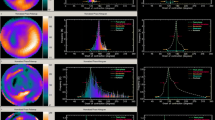Abstract
Two methods for the analysis of left ventricle time-activity curve (TAC) of equilibrium gated ventriculography were compared in three groups of subjects [8 controls, 13 patients with coronary artery disease (CAD), 11 patients with myocardial infarction (MI). The first method was based on third-degree polynomial fitting, the second on Fourier analysis. The following parameters were calculated: peak ejection rate (PER), peak filling rate (PFR), time to PER and PFR, and filling fraction at the first third of diastole.
A preliminary study of changing values of PER and PFR and of the mean error with increasing number of harmonics summed in order to obtain the best fitting of TAC demonstrated that beyond the sum of the first four harmonics there was no further significant improvement.
The advantages of Fourier analysis are as follows:
-
1)
it is independent of the operator and fits only one function to the whole cardiac cycle;
-
2)
it requires less computer time;
-
3)
it provides better differentiation between controls and CAD patients.
All of the 13 CAD patients had abnormal PFR on Fourier analysis, only 9 on polynomial analysis. At rest, 9 of the CAD patients had wall motion abnormalities, while only two had an abnormal ejection fraction.
Similar content being viewed by others
References
Bacharach SL, Green MV, Borer JS, Hyde JE, Farkas SP, Johnston GS (1979) Left-ventricular peak ejection rate, filling rate, and ejection fraction-frame rate requirements at rest and exercise. J Nucl Med 20:189–193
Bacharach SL., Green MV, Vitale D, White G, Douglas MA, Bonow RO, Larson SM (1983) Optimum Fourier filtering of cardiac data: a minimum error method: concise communication. J Nucl Med 24:1176–1184
Bianco JA, Makey DG, Laskey WK, Shafer RB (1979) Radionuclide left ventricular dV/dT for the assessment of cardiac function in patients with coronary disease. J Nucl Med 20:1–6
Bing CH, Keefe JF, Wolk MJ, Finkelstein LJ, Levine HJ (1971) Tension prolongation during recovery from hypoxia. J Clin Invest 50:660
Bonow RO, Bacharach SL, Green MV, Kent KM, Rosing DR, Lipson LC, Leon MB, Epstein SE (1981) Impaired left ventricular diastolic filling in patients with coronary artery disease: assessment with radionuclide angiography. Circulation 64:315–323
Bristow JD, Van Zee BE, Judkins MP (1970) Systolic and diastolic abnormalities of the left ventricle in coronary artery disease: studies in patients with little or no enlargement of ventricular volume. Circulation 42:219–228
Diamond G, Forrester JS (1972) Effect of coronary artery disease and acute myocardial infarction on left ventricular compliance in man. Circulation 45:11–19
Dwyer EM (1970) Left ventricular pressure-volume alterations and regional disorders of contraction during myocardial ischemia induced by atrial pacing. Circulation 42:1111
Frist WH, Palacious I, Powell WJ Jr (1978) Effect of hypoxia on myocardial relaxation in isometric cat papillary muscle. J Clin Invest 61:1218
Grossman W, Barry WH (1980) Diastolic pressure-volume relations in the diseased heart. Fed Proc 39:148–155
Grossman W, McLaurin LP (1976) Diastolic properties of left ventricle. Ann Intern Med 84:316–326
Grossmann W, Mann T (1978) Evidence for impaired left ventricular relaxation during acute ischemia in man. Eur J Cardiol 7:239
Hammermeister KE, Warbasse JR (1974) The rate of change of left ventricular volume in man. II. Diastolic events in health and disease. Circulation 49:739–747
Mancini BJ, Slutsky RA, Norris HL, Bhargava V, Ashburn WL, Higgins HB (1983) Radionuclide analysis of peak filling rate, filling fraction, and time to peak filling rate. Am J Cardiol 51:43–51
Mann T, Goldberg S, Mudge GH, Grossman W (1979) Factors contributing to altered left ventricular diastolic properties during angina pectoris. Circulation 59:14–20
Miller TR, Goldman KJ, Sampathkumaram KS, Biello OR, Luobrook PA, Sobel BE (1983) Analysis of cardiac diastolic function: application in coronary artery disease. J Nucl Med 24: 2–7
Mitchell JH, Linden RJ, Sarnoff SJ (1960) Influence of cardiac sympathetic and vagal nerve stimulation on the relation between left ventricular diastolic pressure and myocardial segment length. Circ Res 8:1100–1107
Reduto LA, Wickenmeyer WJ, Young JB, Del Ventura LA, Reid JW, Glaeser DH, Quinones MA, Miller RR (1981) Left ventricular diastolic performance at rest and during exercise in patients with coronary artery disease: assessment with first-pass radionuclide angiography. Circulation 63:1228–1237
Richards AF, Seabra-Gomes R (1978) Observations on the effect of angina on the left ventricle, with special reference to diastolic behavior. Eur J Cardiol 7:213
Tebbe U, Hoffmeister N, Sauer G, Neuhaus KL, Kreuzer H (1980) Changes in left ventricular diastolic function in coronary artery disease with and without angina pectoris assessed from exercise ventriculography. Clin Cardiol 3:19–25
Weisfeldt ML, Frederiksen JW, Yin FCP, Weiss SL (1978) Evidence of incompleted left ventricular relaxation in the dog: prediction from the time constant isovolumic pressure fall. J Clin Invest 62:1296–1302
Author information
Authors and Affiliations
Rights and permissions
About this article
Cite this article
Zatta, G., Tarolo, G.L., Palagi, B. et al. Computerized analysis of equilibrium radionuclide ventriculography time-activity curve in the assessment of left ventricular performance: comparison of two methods. Eur J Nucl Med 10, 198–202 (1985). https://doi.org/10.1007/BF00254461
Received:
Issue Date:
DOI: https://doi.org/10.1007/BF00254461




